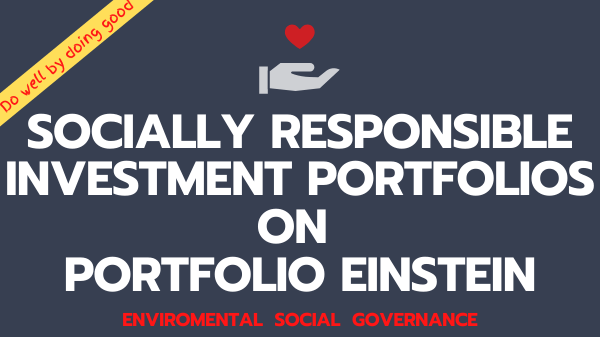ESG investing is a growing investing trend. But what is ESG investing? What hides behind the letters ESG?
Article contents
ESG stands for Environmental, Social, and Corporate governance.
SRI stands for Socially ResponsibleInvesting.
Impact investing is a subset of SRI or ESG.
When we talk about ESG / SRI / Impact investing, we mean investing in companies that have a particular way of dealing with various issues within their company. Those issues are environmental, social, and corporate governance.
Some companies pride themselves on only using renewable energy as their power source. That is an example of a company addressing an environmental issue. If a company makes an effort to close the pay gap between women and men, then that would be a social and maybe a corporate governance issue.
When you invest in an ESG fund or ETF, you invest in a collection of ESG companies that do well by doing good.
PortfolioEinstein.com now tracks ESG investment portfolios.
Let’s take a closer look at ESG, SRI, and Impact Investing.
We start with ESG.
Environmental, Social, and Corporate Governance.
ESG is the broadest of the three and is a catch-all category. It is becoming the standard way of referencing ethical, socially, and environmentally investing.
It is the standard way of communicating the invest ethically mentality.
Usually, when we think about socially responsible investing, we want to exclude certain kind of companies and industries, these could include:
- Tobacco
- Nuclear
- Weapons
- Coal
- Cigarettes
It covers a lot of ground behind every letter and even more so when combining the three letters. Here are some of the issues that ESG investing addresses:
Environmental issues
Climate change
Sustainability
Diversity within companies, both in recruitment as well as leadership selection. Diversity covers gender, race, and religion. The key rallying cry is the “power of difference.”
Human rights, both within the companies as well as within the company’s supply chain
Consumer protection no longer is _buyer beware_enough of an excuse for companies to get away with everything. There is a growing trend in protecting the consumer from willful nefarious companies.
Animal welfare covers testing on animals to animal welfare in production and food production.
Corporate governance issues
Corporate governance covers the area of responsibilities of the management of a company—its board, shareholders, and stakeholders in that company.
- Management structure
- Employee relations, this cover corporate behavior, the company values.
- Executive compensation
- Employee compensation is especially prescient within the gender debate.
Let’s tackle Socially ResponsibleInvesting next
Socially Responsible Investing has come to be known as sustainable,socially conscious, “green,” orethical investing.
In a way, this is a sub-set of ESG investing.
SRI often excludes alcohol, tobacco, fast food, gambling, pornography, weapons, contraception/abortifacients/abortion, fossil fuel production, or the military as these are seen counter to socially responsible behavior.
Impact Investing
Impact investing is devoted to the conscious creation of social impact through investments. Impact investing is done by investing in companies that focus on equality of leadership for both men/women/racial or investing in companies with a focus on bringing down their carbon-emission footprint. It is also used targeting a specific set of industries such as renewable energy, housing project, education, micro-finance, and sustainable agriculture.
Depending on how you look at it, Impact Investing is its own category, or maybe it is just a subset of ESG.
How is ESG measured?
With so many issues to tackle, it is natural to feel overwhelmed by the number of decisions to make concerning ESG investing. How do you measure ESG?
The scoring is done relatively. What this means is that there are no set specific ESG goals for companies to attain. That would be an absolute goal. Instead, when the companies receive an ESG rating, each company is compared to each other on key issues. The winner receives a higher score, while the loser in this peer battle receives a lower score.
Companies are rated on a AAA-CCC scale relative to the standards and performance of their industry peers.
-MSCI ESG Ratings Methodology Whitepaper
This way of scoring results in that the bar is set very low if all the companies in the group perform poorly. But there will always be a “winner.” You win at socially responsible investing by beating others. So, in theory, you don’t have to be s superstar at ESG to score well, you just have to be better than your peers.
Companies show an increasing amount of attention to socially responsible investing concerns within their industry and as a whole. The increased awareness has the effect of a rising upward movement in ESG absolutes scoring because of their battle against their peers. No one wants to be left behind. No one wants to work at a company that ignores the environment, laughs at inequality, or cook their accounting books.
Let’s take a look at those that do the actual socially responsible measurements.
These three companies do the actual ESG scoring
There are three notable actors in the measurements of ESG. Let’s go over them briefly.
The first is Sustainalytics.
Since 1992 Sustainalytics (then called Janzti Research) have tracked companies using various ESG scoring mechanisms.
Their methodology is detailed here.
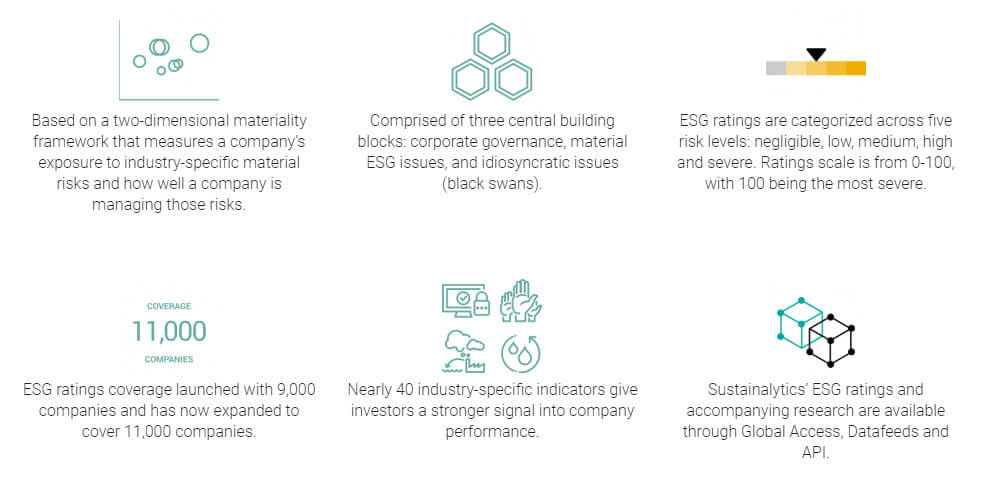
The process of Sustainalytics in scoring companies on ESG. Source: Sustainalytics
The second is Morningstar.
Morningstar uses the Sustainlystics rating engine to present a score for all the funds and ETFs that morningstar.com track. With this in hand, it is straightforward to see which fund ranks high on the socially responsible investing ESG scale and which don’t.
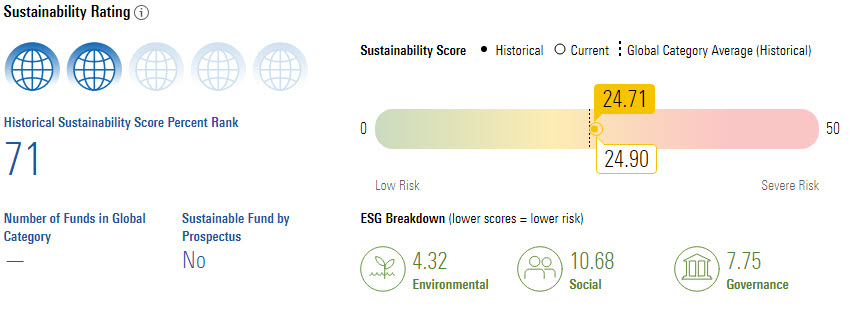
Showing the sustainability rating from morningstar for the Vanguard’s ETF VTI (Total US Stock). Source: Morningstar.com
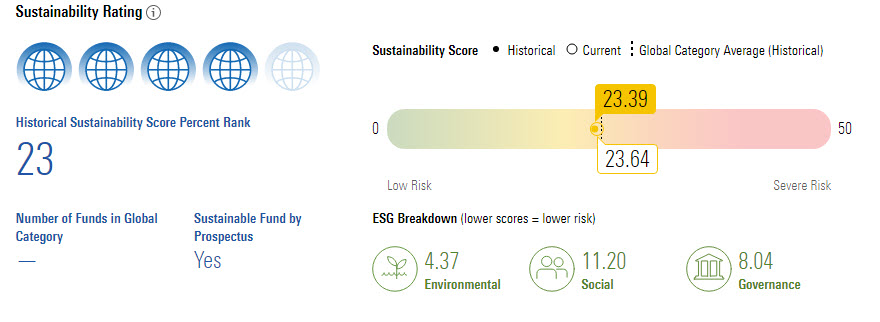
Showing the sustainability rating from morningstar for the iShares ESG ETF ESGU (Total US Stock). Source: Morningstar.com
Morningstar also has a Carbon Metric to score funds on their carbon footprint.

The Carbon Metric from Morningstar with data from Sustainalytics. Source: Morningstar.com
The third is MSCI
MSCI is behind some of the most significant investment indices, fx world index, developed countries, and more.
MSCI also uses a very detailed system for socially responsible investing ESG scoring companies and funds.
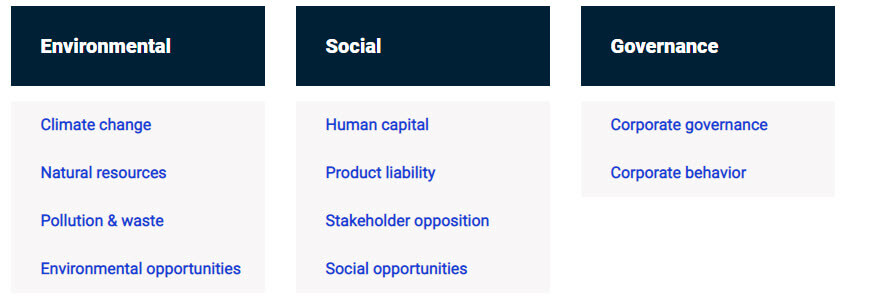
This table from MSCI displays in broad strokes what factors they consider when scoring ESG.
“ESG investing is the consideration of environmental, social and governance factors alongside financial factors in the investment decision–making process.”
– Remy Briand, Managing Director of MSCI ESG Research
They have a very intuitive scoring system that reminds of the credit ratings. It goes form AAA being the best to CCC being the worst.
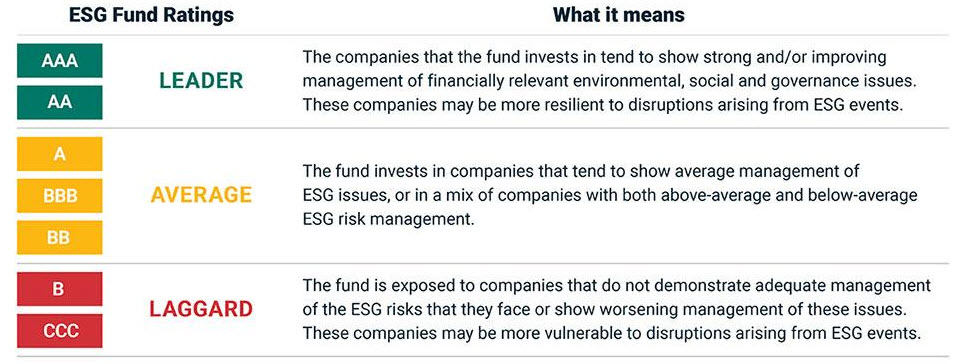
The MSCI ESG rating system. Source MSCI.
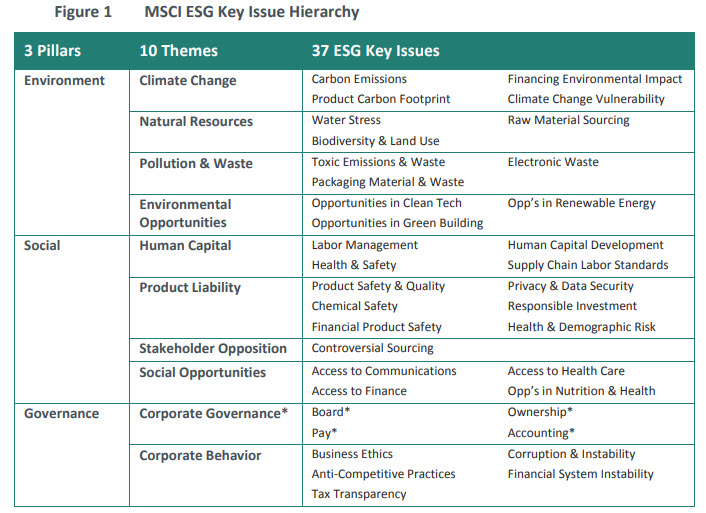
The table shows how MSCI has broken down ESG, scoring into ten pillars and 37 ESG key issues. Source: MSCI
iShares ESG ETFs use the MSCI ESG engine and scoring system to build their ESG ETFs.
There are many reasons why you should care about socially responsible investing.
Let’s go over a few of them.
- Greed. You get higher returns. High scoring socially responsible companies perform better than low ESG scoring companies because the employees feel like they’re doing good in this world or perhaps because the top-scoring ESG companies can attract better talent. Or maybe because the companies don’t have to suffer expensive lawsuits and extreme negative publicity, like this, this and this.
Perhaps because knowing the moral, strategic directions of the company helps everyone in the company make better, faster, and smarter decisions. Google had the three words “Don’t Be Evil” as a moral, strategic direction once to help navigate. That is long gone by now, leaving the employees without a fantastic moral compass.
Betting on high socially responsible ESG scoring companies puts more money in your pocket. This phenomenon is called doing well by doing good.
Voting with your wallet. We can choose to only buy products from a company based its value its attention to climate and so on. We can do the same thing in investing by only investing in companies that score high on an ESG rating. Voting with your wallet may not help in the short-term. The reason for this is that your purchase of shares happens on the secondary market. You purchase shares from other investors in other words, not from the company. Stock prices redetermined by the yoke of supply and demand.
The greater the demand for a stock, the higher the price. This means that companies in which a stock enjoys a high demand will see their stock price increase while the opposite is also true. If your company’s stock is in low demand, the stock price goes lower. Many factors go into creating the demand for a company’s stock. When a company is hit with bad publicity fx when Shell (oil manufacturer) experienced a boycott in 1995 (the Brent Spar controversy), its share price dropped due to its imminent drop in future earnings. People were voting with their wallets. The share price has no direct relationship to how well a company is performing. However, it does have indirect consequences, like CEO compensation, the company’s ability to use their stock as a method of payment for buy-outs, etc. In this way, companies will feel the consequences when no one wants to buy their stock.
Because you care about the future of our planet and our culture.
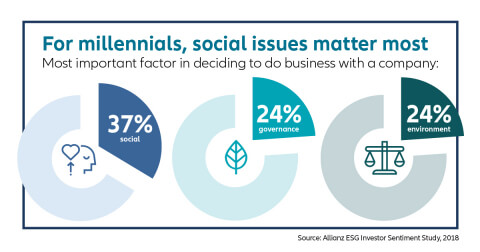
Pick your battles, but DO pick
If you consider being a socially responsible investing ESG investor, you should find which issues you consider important.
“All companies kill”
Weapons and coal are apparent and concise industry contenders to exclude from an investing strategy. We can see, and we can measure their negative impacts. But what of companies that exert adverse and invisible effects on society?
Google and Facebook, for example, promote anti-social behavior, affect our minds in subtle negative ways and, filters our access to information, and cause depression. They do this openly. It is their business model to do so. Are they also to be excluded from socially responsible ESG investing?
When you start to dive into socially responsible investing, you quickly find out that you need to pick your battles. You can’t focus on everything at once. But you need to pick something. If you don’t pick something, you let others pick something for you, and that is a choice as well.
“If you’re not actively seeking out ESG investing possibilities, then you are passively accepting a bleak and scary future for your children.”
Your $100 investment in a morally and ethical company may not seem like it will change much. But look at it this way, if you don’t start investing in high scoring ESG companies, there’s a 100% chance that NOTHING will happen and nothing will change. If you shift to ESG investing, you at least have a small percentage chance of affecting the future of our planet and culture.
Let’s now turn to the practicalities of ESG investing.
Socially responsible investing funds and ETFs
Socially responsible investing ESG funds and ETFs that are tracked by Morningstar and MSCI all have a rating.
Funds that want to market themselves as socially responsible ESG funds have selected to include only companies that meet specific standards on the ESG scoring board. This is called screening. The companies that have a low carbon footprint, for example, or that promote equality of leadership or have a transparent way of governing are included in the ESG screen.
The screening also means that certain types of companies are excluded from socially responsible ESG funds and ETFs. Coal companies, tobacco companies, and weapon manufacturers are often excluded from an ESG fund or ETF.
Socially responsible investing is a relatively new phenomenon, but it is quickly attracting attention. Here you can read how Portfolio Einstein makes its ESG investment portfolios.
Because of its newness, there are a limited number of dedicated ESG / SRI / Impact portfolios. Some robo-advisors have begun to implement ESG components into their portfolios. These include Ellevest, Betterment, and a few others.
Most portfolios are only partially ESG invested. This is because you cannot, at present, make a high complexity portfolio from only ESG funds. The ESG funds and ETFs do not exist. Finding ESG funds that only contain value investing style companies in the U.S. is impossible. They don’t exist (yet). This means that if your portfolios include a value company ETF there is no easy way to replace that fund with an ESG fund.
I foresee a value ESG fund will come eventually. We will come to see the full regiment of ESG funds and ETFs for the most used asset classes within long. This is because the Millenial generation is more aware of social issues and environmental issues than previous generations. As the millennials become a greater investing force, they will shift the investing landscape towards socially responsible investing. It is as Thomas Kuhn quoted Max Planck for his timeless book The Structure of Scientific Revolutions: the persons with old thought patterns have to die out to give way to make room for new thinking and practics.
“A new scientific truth does not triumph by convincing its opponents and making them see the light, but rather because its opponents eventually die, and a new generation grows up that is familiar with it”
Thomas Kuhn quoting Max Planck
The way most providers of socially responsible investment portfolios, like robo-advisors, construct their ESG investment portfolios is this. They replace funds in their standard portfolios with ESG funds or ETFs. There is no need to touch the original asset allocation just because it is an ESG investment portfolio. The investment principles of diversification and risk exposure still hold in ESG investment portfolios.
Here at Portfolio Einstein, we use this exact approach to make ESG investment portfolios. We replace standard funds with ESG funds. Here’s an example:
When a standard portfolio contains a U.S. Total Stock Market allocation, we use the ETF with the ticker symbol VTI to track that asset class. In a socially responsible enabled portfolio, we replace the ETF with an ETF that tracks high scoring ESG companies and that track the same asset class. In this case, the ESG ETF that best captures the Total Stock Market is the iShares Total Stock Market ESG ETF with the ticker symbol ESGU.
At present (2020), we can replace seven standard asset classes with comparable socially responsible investing ESG ETFs. This means that all portfolios that contain these asset classes can be included in our ESG investment portfolios.
The Socially Responsible Investing asset classes are:
- Total U.S. Stock Market
- Large Cap Blend (S&P 500)
- Small-Cap Blend
- International Developed
- Emerging Markets
- Total Bond Market
- Inter. Term Corporate Bond
- Short-Term Investment Grade
For the socially responsible investment portfolios, our backtesting data is minimal. We can only backtest ESG investment portfolios back to and including 2017. We could bend our requirements or massage the data to achieve a more extended backtest set. This would compromise the validity of the portfolios, and we wouldn’t have a high enough fidelity to reality to make much sense.
One of the oldest time-series of socially responsible investing ESG funds is the iShares MSCI KLD 400 Social ETF. It is a large-cap blend ETF. This ETF was created in 2006.
75% is the magic number
When we can replace 75% of the portfolio’s allocation with socially responsible investing ESG funds, we begin to track it as an ESG enabled portfolio.
This means that your portfolio will not be 100% ESG enabled. But your portfolio will NEVER be 100% ESG. To put it dramatically: As quoted above, all companies kill. Your job is to figure out who you want dead the least and then invest in those companies or industries that promote that view.
You can get an overview of all the socially responsible investing ESG investment portfolios by visiting our ESG Investmestment portfolio page.
We are rolling out all the portfolios and we have already begun with the famous 60/40 portfolio. You can find that here.
In the coming weeks, we’ll catch up with all socially responsible investing ESG portfolios. We will do benchmarks and a ton of more interesting things.
We have updated the Best In Class ETFs article to now include The best ESG ETFs. We have also listed their respective dividends yield and expense ratio. You can find it here What Is The Best ETF And Mutual Fund?
Summary
Socially responsible investing /ESG / SRI and impact investing is a complex investing territory but one that you shouldn’t and really can’t overlook.
Portfolio Einstein has begun to track and benchmark many ESG investment portfolios. It is now easy to invest with a good conscience. You can now easily invest in sustainable green companies with a diversified portfolio. You can invest for higher profits!

